Abstract
Epithelial cells of 99% purity and 92% viability were isolated from human tracheas obtained post mortem, and the cellular pathways for lipoxygenation of arachidonic acid were examined in vitro. The lipoxygenase metabolites were identified by comparison with synthetic standards during reversed-phase and straight-phase high-pressure liquid chromatography, UV spectroscopy, and gas chromatography/mass spectrometry. Epithelial cells incubated without arachidonic acid failed to generate detectable quantities of metabolites, while cells incubated with arachidonic acid at 1-50 micrograms/mf for 1-30 min invariably generated predominantly 15-lipoxygenase products, including 15-hydroxyicosatetraenoic acid (15-HETE), four isomers of 8,15-dihydroxyicosatetraenoic acid (two 8,15-diHETES and two 8,15-leukotrienes), at least one isomer of 14,15-dihydroxyicosatetraenoic acid, and smaller amounts of 12-HETE and 8-HETE, but little or no detectable 5-HETE or 5,12-diHETEs. The capacity of epithelial cells from human pulmonary airway to selectively generate 15-lipoxygenase metabolites of arachidonic acid suggests a potential role for the products as mediators of airway epithelial function.
Full text
PDF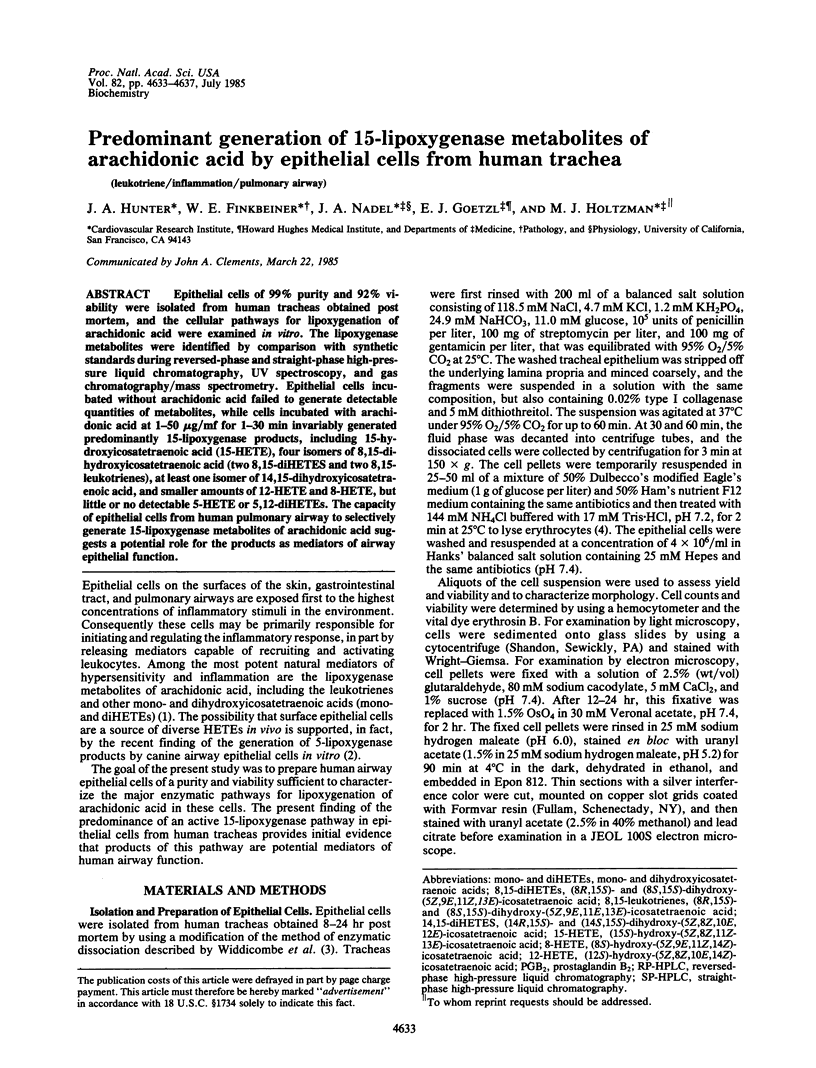
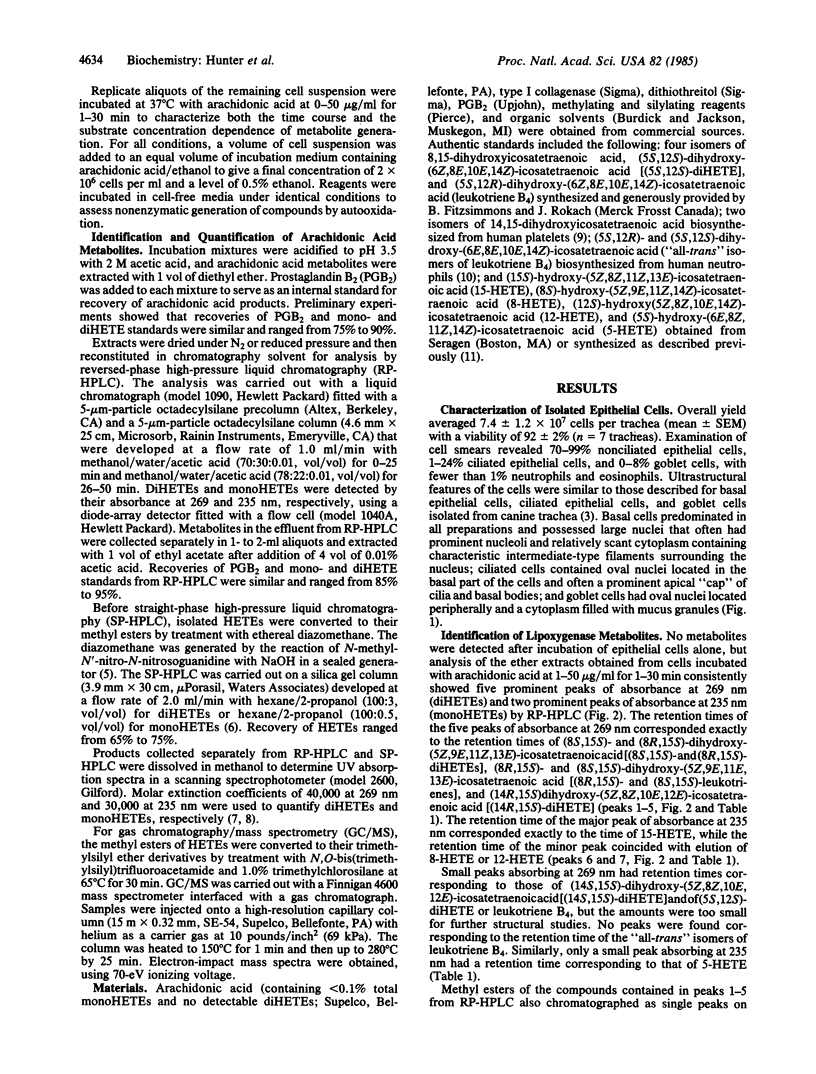
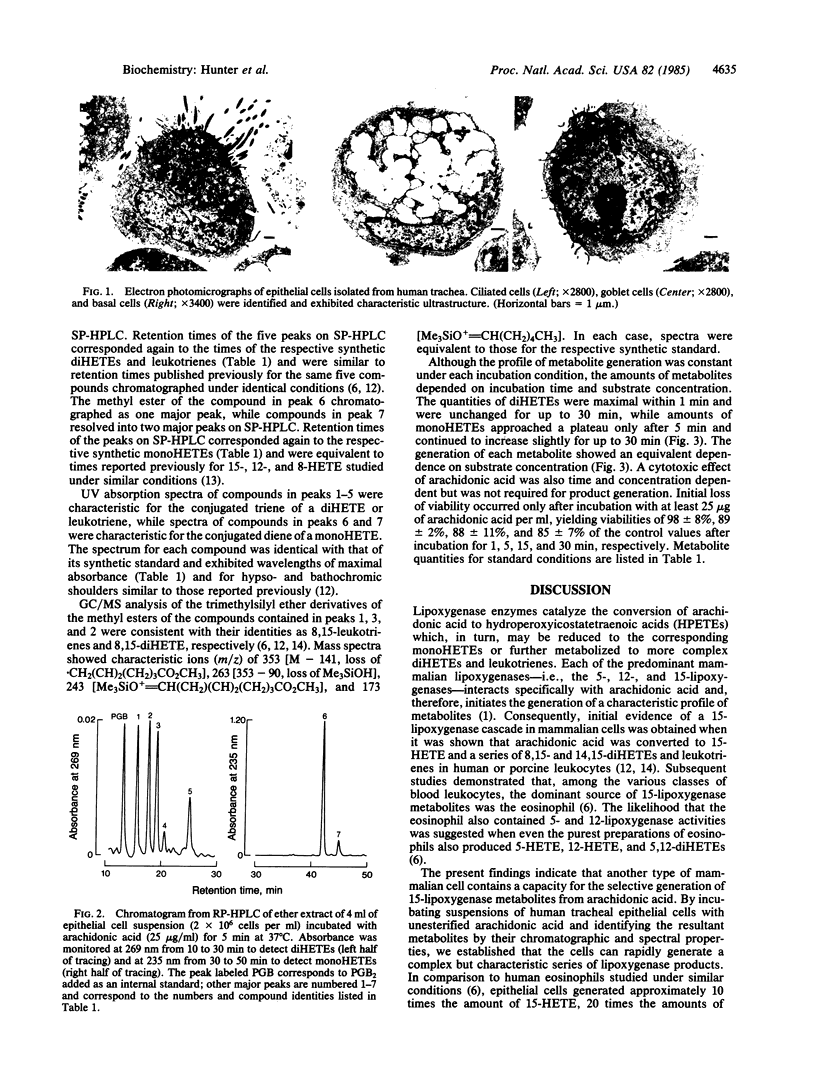
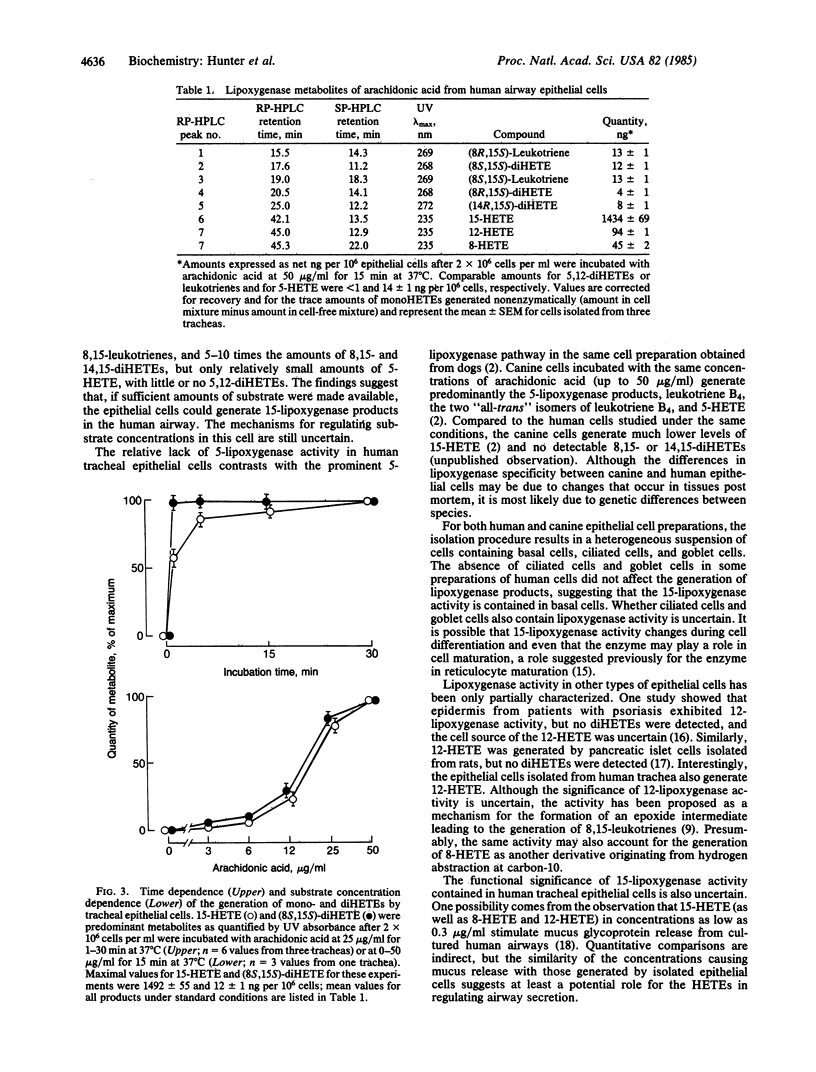
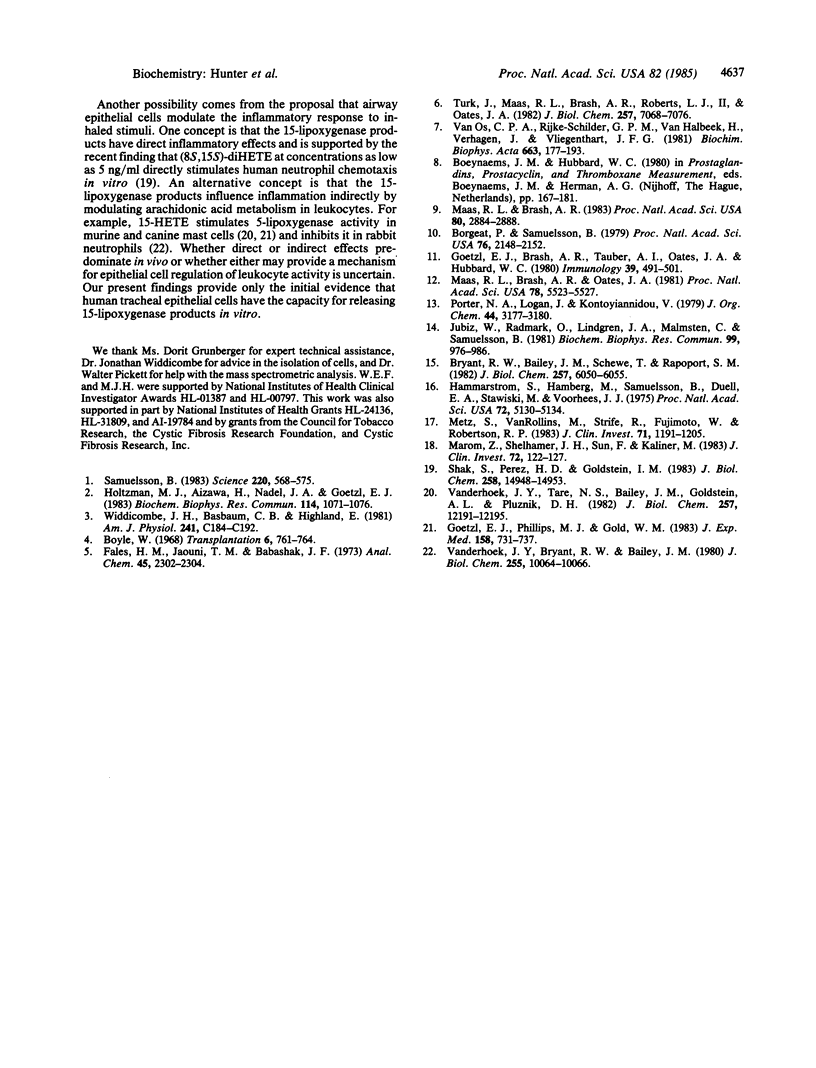
Images in this article
Selected References
These references are in PubMed. This may not be the complete list of references from this article.
- Borgeat P., Samuelsson B. Arachidonic acid metabolism in polymorphonuclear leukocytes: effects of ionophore A23187. Proc Natl Acad Sci U S A. 1979 May;76(5):2148–2152. doi: 10.1073/pnas.76.5.2148. [DOI] [PMC free article] [PubMed] [Google Scholar]
- Boyle W. An extension of the 51Cr-release assay for the estimation of mouse cytotoxins. Transplantation. 1968 Sep;6(6):761–764. doi: 10.1097/00007890-196809000-00002. [DOI] [PubMed] [Google Scholar]
- Bryant R. W., Bailey J. M., Schewe T., Rapoport S. M. Positional specificity of a reticulocyte lipoxygenase. Conversion of arachidonic acid to 15-S-hydroperoxy-eicosatetraenoic acid. J Biol Chem. 1982 Jun 10;257(11):6050–6055. [PubMed] [Google Scholar]
- Goetzl E. J., Brash A. R., Tauber A. I., Oates J. A., Hubbard W. C. Modulation of human neutrophil function by monohydroxy-eicosatetraenoic acids. Immunology. 1980 Apr;39(4):491–501. [PMC free article] [PubMed] [Google Scholar]
- Goetzl E. J., Phillips M. J., Gold W. M. Stimulus specificity of the generation of leukotrienes by dog mastocytoma cells. J Exp Med. 1983 Sep 1;158(3):731–737. doi: 10.1084/jem.158.3.731. [DOI] [PMC free article] [PubMed] [Google Scholar]
- Hammarström S., Hamberg M., Samuelsson B., Duell E. A., Stawiski M., Voorhees J. J. Increased concentrations of nonesterified arachidonic acid, 12L-hydroxy-5,8,10,14-eicosatetraenoic acid, prostaglandin E2, and prostaglandin F2alpha in epidermis of psoriasis. Proc Natl Acad Sci U S A. 1975 Dec;72(12):5130–5134. doi: 10.1073/pnas.72.12.5130. [DOI] [PMC free article] [PubMed] [Google Scholar]
- Holtzman M. J., Aizawa H., Nadel J. A., Goetzl E. J. Selective generation of leukotriene B4 by tracheal epithelial cells from dogs. Biochem Biophys Res Commun. 1983 Aug 12;114(3):1071–1076. doi: 10.1016/0006-291x(83)90671-x. [DOI] [PubMed] [Google Scholar]
- Jubiz W., Rådmark O., Lindgren J. A., Malmsten C., Samuelsson B. Novel leukotrienes: products formed by initial oxygenation of arachidonic acid at C-15. Biochem Biophys Res Commun. 1981 Apr 15;99(3):976–986. doi: 10.1016/0006-291x(81)91258-4. [DOI] [PubMed] [Google Scholar]
- Maas R. L., Brash A. R. Evidence for a lipoxygenase mechanism in the biosynthesis of epoxide and dihydroxy leukotrienes from 15(S)-hydroperoxyicosatetraenoic acid by human platelets and porcine leukocytes. Proc Natl Acad Sci U S A. 1983 May;80(10):2884–2888. doi: 10.1073/pnas.80.10.2884. [DOI] [PMC free article] [PubMed] [Google Scholar]
- Maas R. L., Brash A. R., Oates J. A. A second pathway of leukotriene biosynthesis in porcine leukocytes. Proc Natl Acad Sci U S A. 1981 Sep;78(9):5523–5527. doi: 10.1073/pnas.78.9.5523. [DOI] [PMC free article] [PubMed] [Google Scholar]
- Marom Z., Shelhamer J. H., Sun F., Kaliner M. Human airway monohydroxyeicosatetraenoic acid generation and mucus release. J Clin Invest. 1983 Jul;72(1):122–127. doi: 10.1172/JCI110949. [DOI] [PMC free article] [PubMed] [Google Scholar]
- Metz S., VanRollins M., Strife R., Fujimoto W., Robertson R. P. Lipoxygenase pathway in islet endocrine cells. Oxidative metabolism of arachidonic acid promotes insulin release. J Clin Invest. 1983 May;71(5):1191–1205. doi: 10.1172/JCI110868. [DOI] [PMC free article] [PubMed] [Google Scholar]
- Samuelsson B. Leukotrienes: mediators of immediate hypersensitivity reactions and inflammation. Science. 1983 May 6;220(4597):568–575. doi: 10.1126/science.6301011. [DOI] [PubMed] [Google Scholar]
- Shak S., Perez H. D., Goldstein I. M. A novel dioxygenation product of arachidonic acid possesses potent chemotactic activity for human polymorphonuclear leukocytes. J Biol Chem. 1983 Dec 25;258(24):14948–14953. [PubMed] [Google Scholar]
- Turk J., Maas R. L., Brash A. R., Roberts L. J., 2nd, Oates J. A. Arachidonic acid 15-lipoxygenase products from human eosinophils. J Biol Chem. 1982 Jun 25;257(12):7068–7076. [PubMed] [Google Scholar]
- Van Os C. P., Rijke-Schilder G. P., Van Halbeek H., Verhagen J., Vliegenthart J. F. Double dioxygenation of arachidonic acid by soybean lipoxygenase-1. Kinetics and regio-stereo specificities of the reaction steps. Biochim Biophys Acta. 1981 Jan 26;663(1):177–193. doi: 10.1016/0005-2760(81)90204-6. [DOI] [PubMed] [Google Scholar]
- Vanderhoek J. Y., Bryant R. W., Bailey J. M. Inhibition of leukotriene biosynthesis by the leukocyte product 15-hydroxy-5,8,11,13-eicosatetraenoic acid. J Biol Chem. 1980 Nov 10;255(21):10064–10066. [PubMed] [Google Scholar]
- Vanderhoek J. Y., Tare N. S., Bailey J. M., Goldstein A. L., Pluznik D. H. New role for 15-hydroxyeicosatetraenoic acid. Activator of leukotriene biosynthesis in PT-18 mast/basophil cells. J Biol Chem. 1982 Oct 25;257(20):12191–12195. [PubMed] [Google Scholar]
- Widdicombe J. H., Basbaum C. B., Highland E. Ion contents and other properties of isolated cells from dog tracheal epithelium. Am J Physiol. 1981 Nov;241(5):C184–C192. doi: 10.1152/ajpcell.1981.241.5.C184. [DOI] [PubMed] [Google Scholar]



